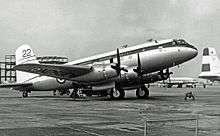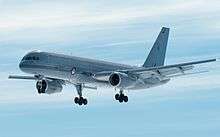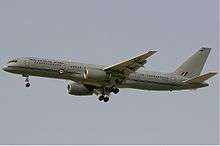No. 40 Squadron RNZAF
| No. 40 Squadron RNZAF | |
|---|---|
|
Boeing 757 of the RNZAF in 2009. | |
| Active |
June 1943 – October 1947 December 1954 – present |
| Country |
|
| Branch |
|
| Role | Strategic and Tactical Air Transport |
| Garrison/HQ | RNZAF Base Auckland |
| Motto(s) |
Maori: Ki nga hau e wha English: To the four winds |
| Mascot(s) | Mariners compass star |
| Anniversaries | 1 June |
| Equipment |
2 x Boeing 757s 5 x C-130H Hercules |
| Engagements | World War II, Korean War, Malaya, Vietnam War, Rwanda, Somalia, Gulf War, East Timor, Solomon Islands, Iraq, Operation Enduring Freedom. |
| Commanders | |
| Current commander | Wing Commander Andy Scott |
| Insignia | |
| Squadron Badge | A Mariners compass representing the "Four winds." |
No. 40 Squadron RNZAF is a transport squadron in the Royal New Zealand Air Force (RNZAF). It remains on active duty.

History
Origins
The squadron was formed at Whenuapai on 1 June 1943 as No. 40 Transport Squadron RNZAF. It was equipped with Dakota and Lockheed Lodestars and carried men and supplies to forward areas throughout the Pacific theatre. Within the squadron organisation was a ferry flight of aircrew which regularly flew delivery flights from the mainland United States and Hawaii to New Zealand of new aircraft such as the Catalina flying boat and Ventura. The squadron was disbanded on 31 October 1947 and most of its crews and aircraft were transferred to the government-owned National Airways Corporation.
No. 40 Squadron reformed on 8 December 1954 with four Handley Page Hastings, one of which had competed in the October 1953 London-Christchurch air race. The Squadron was supplemented with three Douglas DC-6 acquired from the defunct Australian airline, British Commonwealth Pacific Airlines by 1961. The three current Lockheed C-130H Hercules were purchased in 1965 and two more in 1968.
Boeing 727
Three Boeing 727s were purchased second hand from Boeing in 1981, all ex-United Airlines. NZ7271 19892 entered service in July 1981 and was retired on 7 July 2003. (It became 3D-KMJ and then 9Q-CMP in Africa and was scrapped in 2005). NZ7272 19893 entered service in July 1981 and was retired to Woodbourne as an instructional airframe on 25 August 2003. NZ7273 19895 was the first 727 delivered, on 6 May 1981, but flew only 21 hours, being intended from the start to be a source of spare parts. It was retired 25 June 1981.[1] The 727s were purchased by the administration of Sir Rob Muldoon and used by the fourth and fifth Labour governments, as well as the administration of Jenny Shipley. The Boeing 727s were replaced in 2003 by two Boeing 757s.
_91.jpg)
Present
Located at RNZAF Base Whenuapai 40 Squadron today operates five C-130H Hercules and two Boeing 757s.

The squadron saw action throughout the pacific war against Japan, helped supply New Zealand forces fighting in Korea, Malaya, Vietnam, East Timor, Afghanistan, and Iraq, and provided transport to United States and United Kingdom forces in the 1990 Gulf War.
Humanitarian missions have included flying in the first Cyclone Tracy relief supplies to Darwin, assisting victims of the Bali bombing and the Boxing Day Tsunami. Since the late 1960s the squadron has detached aircraft each summer to work in the Ross Dependency of Antarctica.
A major operation for the squadron was the 2011 Christchurch earthquake which saw nearly the entire fleet working around the clock distributing personnel, freight, SAR teams and medical supplies to the people of Christchurch. 40 Squadron aircraft worked in conjunction with C-130s from the Republic of Singapore Air Force, Royal Australian Air Force, and U.S. Air Force.
40 Squadron is held in high regard internationally having won various tactical flying competitions in the USA competing against other air forces in exercises such as Green Flag East at Little Rock Air Force Base, Arkansas.
Fleet
Boeing 757
In 2003 two second-hand Boeing 757s were purchased from Transavia, which 40 Squadron operate in transport, freight, cargo and troop movement roles. They can also be converted for medical use in emergencies. Their registrations are NZ7571 and NZ7572.

C-130 Hercules
The RNZAF purchased three Hercules (NZ 7001, NZ7002, NZ7003) from the USA in 1965 and another two aircraft (NZ 7004, NZ7005) in 1968. Since the introduction of the type they have been involved extensively carrying freight, troops, and providing humanitarian relief to countries all over the world.
_of_No_40_Squadron_of_the_Royal_New_Zealand_Air_Force_at_Hobart_International_Airport.jpg)
Fleet upgrade
In 2008, the squadron began modernising its Hercules aircraft with new avionics, centre wing refurbishment, aircraft systems upgrade, and complete re-wiring and replacement of major parts and interior to extend their life expectancy (for NZ$234 million).
The package for each aircraft was known as the Life Extension Programme (LEP). Initially two aircraft were completed in Canada however the programme ran into difficulties when the company tasked with carrying out the refurbishments went into receivership. The remaining aircraft were then completed by Safe Air in Blenheim, New Zealand.
The Hercules fleet now operate with glass cockpits and had one of the most extensive upgrades ever completed on this type of aircraft anywhere in the world. The last Hercules aircraft to be upgraded NZ7002, will be completed by the end of 2016. The Hercules fleet is due to be replaced by 2020.
The Boeing 757s were also upgraded with new avionics and more powerful engines. A cargo door was also fitted to allow pallet loading and an aero medical facility if needed.[2]

Future procurement
Since 2015 the RNZAF has been looking to replace the C-130 Hercules fleet and the Boeing 757s. This is due to take place over the next five years due to the C-130s and Boeing 757s reaching the end of their flying life by 2020.
The aircraft under consideration by the RNZAF for replacement of the C-130s and Boeing 757s are the C-17 Globemaster, Airbus A400M, Embraer KC-390, Lockheed Martin C-130J Super Hercules. The New Zealand government has set aside about $1 billion to replace the transport fleet.
References
- ↑ "RNZAF Boeing 727-22QC: NZ7271 to NZ7273". NZDF Serials. Retrieved 16 July 2015.
- ↑ Mateparae, Jerry (8 September 2008). "Jerry Mateparae: Can't fight? In fact we still punch above our weight". The New Zealand Herald. Retrieved 31 October 2011.
